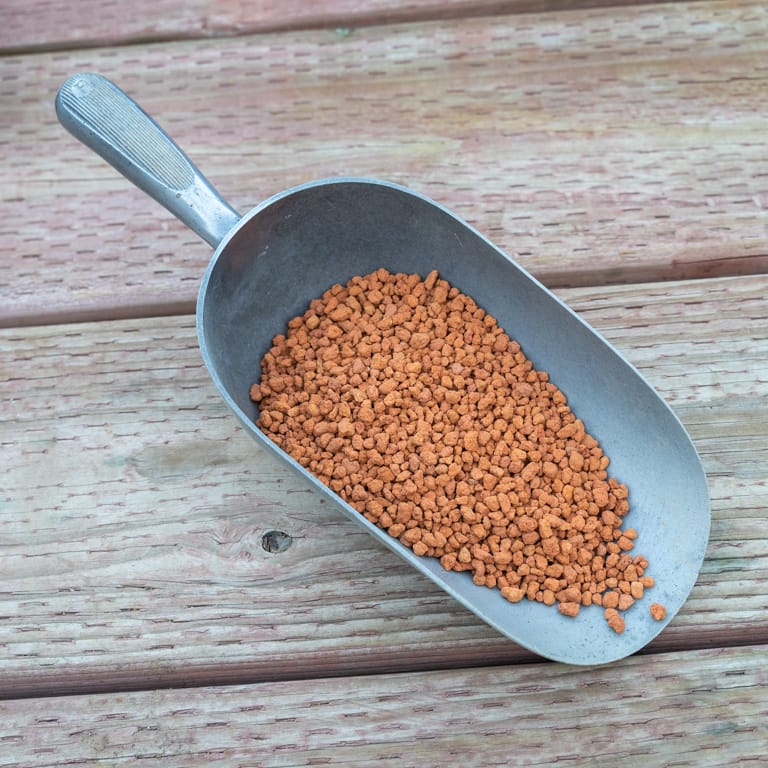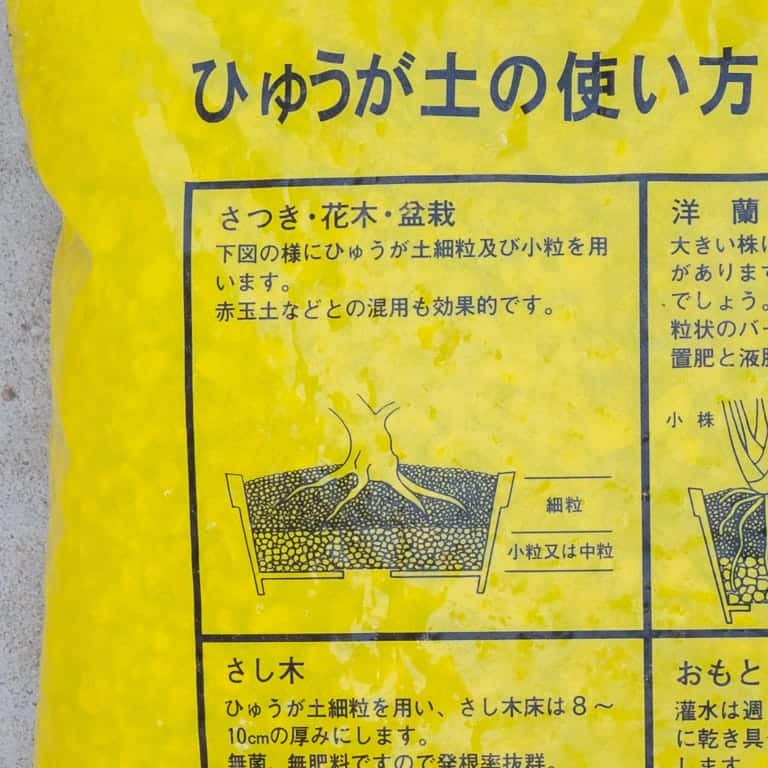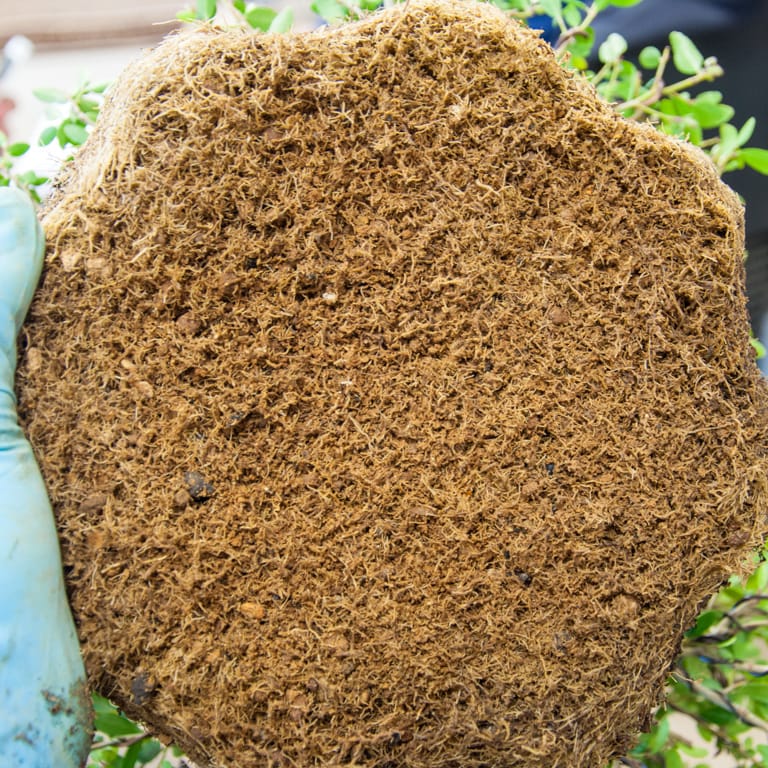Several years ago I wrote about bonsai soil in a post titled “All about akadama.” (If you haven’t read it, you can check it out here.)
I continue to get questions on the topic so I thought I’d provide a few updates.
Q. What is baked akadama and is it useful for bonsai?
Baked akadama is akadama that has been baked at temperatures of up to 800 degrees Celsius. The akadama becomes hard, almost like ceramic pebbles, at higher temperatures, which means it resists breaking down in the pot. It’s not commonly used for bonsai but it can be a component of bonsai mixes – it just won’t do the same job as non-baked akadama.

Orange-hued baked akadama
Q. Is heat-treated akadama the same as baked akadama?
No. Some brands of akadama are exposed to temperatures around 300 degrees Celsius in order to kill any organic compounds found in the akadama. Heat treatments are done to meet import requirements and do little if anything to harden the akadama. Most popular brands of akadama are air-dried instead of heat-treated.
Q. What are the differences between hard and soft akadama?
Over time, most akadama particles break down in the soil. The hardness or softness of the akadama affects the rate at which the particles break down.
Both hard and soft akadama can be used to great effect in the cultivation of bonsai. The selection of one over the other depends on one’s cultivation goals for a given tree or species.
For example, I might use a lower percentage of akadama (and a higher percentage of lava rock or pumice) when the particles are soft as this is an easy way to maintain good drainage or aeration.
In terms of the qualitative difference between the two, soft akadamas crumble easily between pinched fingers. Hard akadama particles are more difficult to break.
Q. What is the best bonsai soil particle size to use for my bonsai?
In general, smaller particles are a good fit for smaller trees and larger particles are a good fit for larger trees. Species that prefer moist environments (like wisteria or coast redwood) can benefit from smaller particle sizes as they provide greater water retention. Species that prefer drier root environments can benefit from mixes with larger particle sizes.
Q. What is a drainage layer and do I need one?
Drainage or aeration layers are layers of soil with lower porosity (more air). It’s common practice to improve porosity in the bonsai pot by using larger soil particles and/or particles that resist breaking down.
One common approach is to use the same soil components at the bottom of the pot as at the top of the pot but with larger particle sizes. Another approach is to use particles like pumice that resist breaking down (and weigh less!). Both approaches can encourage root growth in the lower region of the pot for species that resist growing roots in overly moist environments.

Instructions for using hyuga, Japanese pumice, indicating larger particle sizes along the bottom of the pot
Q. Do all bonsai benefit from akadama-based soils?
No! Lots of soil mixes that don’t contain akadama can be used to great effect. I’m currently using very little if any akadama for the development of young trees. My chojubai (dwarf flowering Japanese quince), for example, have been growing well in 100% lava rock (aka scoria or cinder).
Eric Schrader recently posted a great video on the topic on the Bonsaify channel. You can check it out here.
You can also read more about the topic in the post: “What kind of soil should I use for my bonsai?“
Q. Can I change my soil mix to accommodate my watering needs?
Yes! Many bonsai growers have limited time to water their trees and select soil mixes that help them meet their watering goals. If your trees dry out while you’re at work, try using smaller particle sizes or a higher percentage of components with good water holding capacity the next time you repot. If you live where temperatures are mild and your soil never dries out, try using mixes with larger particles or particles with a lower water holding capacity.
Q. Are there good alternatives to akadama?
Yes and no. I don’t know of any soil particle that does what akadama does in terms of its ability to hold and release water, hold and release fertilizer, and support root growth over very long periods of time. That said, there are particles with different characteristics that can do a great job supporting tree health and development.
Put another way, I’m happy to use akadama alternatives when akadama isn’t available, but I appreciate different things about these alternatives (see “What to do when akadama is in short supply” for details).
Fortunately, akadama remains available from a variety of outlets. Soil has been on my mind lately as I just received two new shipments and have plenty of hard akadama and hard akadama-based pre-mixes that are available for local pickup in the San Francisco Bay Area, online from the Bonsai Tonight Online Store, and in bulk for orders of 50 bags or more.

Healthy roots
Have any questions (or suggestions) about bonsai soil? Leave them in the comments below!
Subscribe to Bonsai Tonight
New Posts Delivered Every Tuesday and Friday
Stephen Haber says
This article motivated me to read ‘All about akadama’. Though I’ve heard about Boon Mix before, this was the first time I paid attention to the components. Do you know if Boon ever described how he came up with the mix? Has the function of the horticultural charcoal and the decomposed granite been described?
Jonas Dupuich says
Good question – I don’t know if there’s a story behind the mix, but I do know that Boon looked at the soil mixes he was using in Japan and reproduced elements of them based on what was available domestically.
Charcoal’s use as a soil amendment has been documented for years (look for biochar), but I don’t know if much has been written about the DG. At most there may be some nutrient release but I’d guess it primarily serves as filler. In some regions of Japan (Shikoku), bonsai growers (specifically pine growers) commonly use 100% “river sand” in their mixes which is similar to our DG.
Kyle Purvis says
Really great description of soil component and the why! Thanks!
I’ll post a link to the beginner bonsai FB page- field so many questions regarding soil!
As a note I’m in the south east, very hot and constant humidity- I have substituted expanded shale for akadama in my soil mixes with really good results thus far! It’s heavier but has a good ion exchange rate, and holds some moisture and fertilizer for trees to access! Will not break down in the wet/humid conditions solved many root issues I was seeing in my growing operation.
Jonas Dupuich says
Thanks, Kyle!
Anthony Navarro-Liu says
Hi, Jonas!
I’m currently reading “Bonsai Heresy” by Michael Hagedorn in which he talks about the benefits and drawbacks of different types of soils at different stages in bonsai development. One thing he says is that organic media is better for developing younger trees at a faster rate. Of course, my initial thought was “heresy!” but he made a very convincing argument as to why organic media is better for younger trees and more traditional akadama-based media was better for growing more developed trees that are already in bonsai containers.
However, I see that, in this post, you say that you’re developing younger trees in pure lava rock, so I’m very confused by the conflicting information. I’ve also heard in the past that the secret to thick JBP trunks for growers in the Pacific NW is pure pumice because of the constant oxygen flowing to the roots coupled with more frequent watering. I would appreciate any clarification on this. Thanks!
Jonas Dupuich says
Hi Anthony! The big takeaway is that there are different good approaches. Using organic components for young trees works great for different species and in different locations. I’m mostly trying the lava rock to see what I can learn, and so far I’ve been surprised that it works as well as it does.
And while pure pumice is great, I’ve actually tried that many many times for pines and I’m not a fan. I’d rather grow them with a little organic material. The takeaway there too is that larger particles or particles that retain less water lead to faster growth.
Sebastian Fraye says
Thanks for sharing this information! I was curious to the amount of Akadama if any you use for your Coast Live Oaks? And if you are repotting them out of nursery soil for the first time, would you use a different amount of Akadama then if you were repotting one thats already in bonsai soil? Also have you ever tried Boon’s mix on a coast live oaks, specifically the addition of Charcoal with any noticeable difference? Also thank you for the Pumice shipment, hard to find locally for me and how it was packed was impressive!
Jonas Dupuich says
Thanks, Sebastian! And good question about coast live oaks. I can’t say I’ve figured anything out about them, but I have seen that they love mixes high in pumice when they are weak. Typically I’ve been using between 30-70% akadama and I don’t know that I have strong recommendations about the size or composition of the soil. Whatever mixes I’ve used (and some friends have used) they seem to cycle through good and bad times totally apart from how they are pruned or what mix they are growing in. I’d like to grow a batch of them over a number of years to see if it’s easier to identify patterns about what works best.
As for the charcoal, I haven’t seen anyone demonstrate much of a difference either way.
Anthony says
Hi Jonas!
Great post explaining different types of akadama.
The baked akadama at 800 degrees celcius has caught my attention. How would it compare to Calcined Clay? In terms of porosity, moisture retention, etc?
Jonas Dupuich says
Thanks, Anthony! I don’t know how the baked akadama compares with calcined clay, it’s a good question. There are a lot of relatively similar particles but subtle differences can effect performance in the pot. Will have to share if I can find any good info about it!
Sean says
Don’t forget aesthetics! I think medium particles look the best, on most sizes. I’ve also mixed some baked akadama in with regular soft akadama, and it gives the mix nice color. For the same aesthetic reason, hyuga pumice is great because it is a much nicer shade than white pumice.